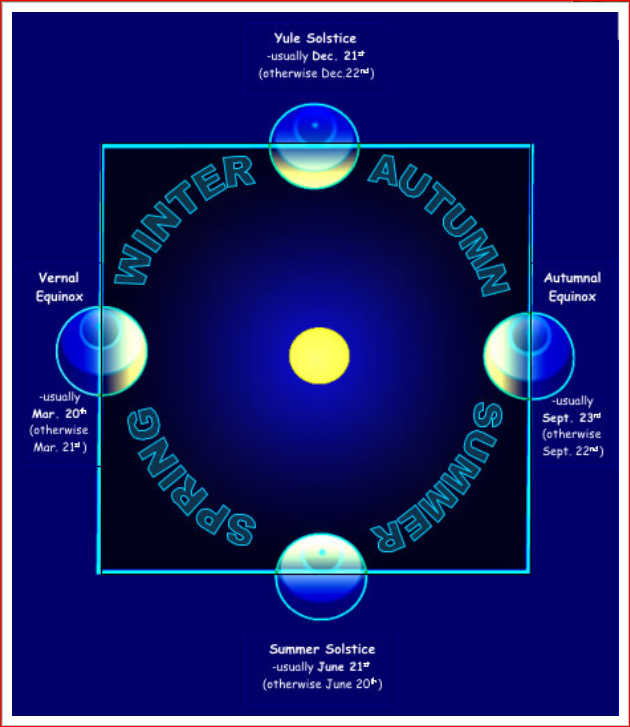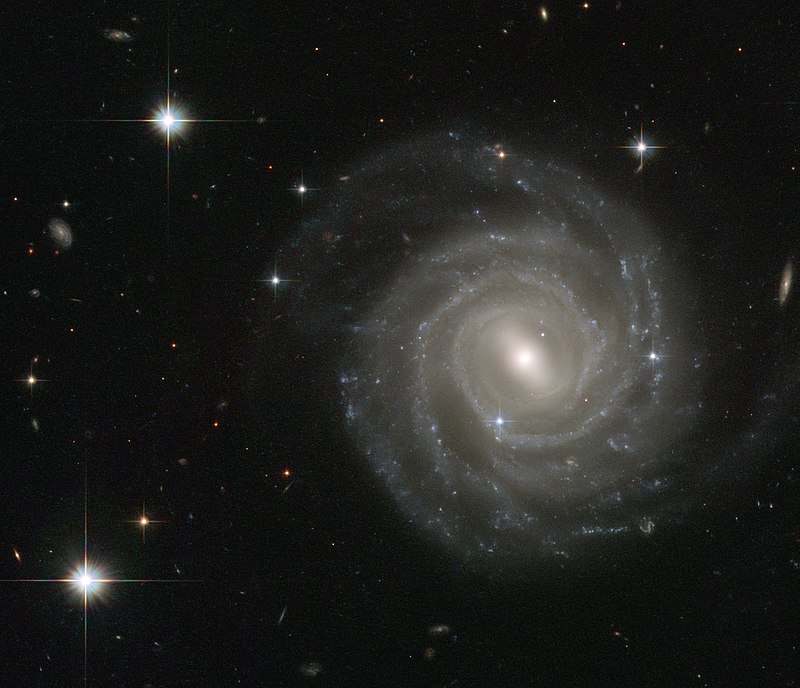
This diagram shows the position of the Earth, in relation to the Sun, at the time of the Vernal Equinox at the official beginning of the season of Spring in the Earth's Northern Hemisphere (Autumn in Earth's Southern Hemisphere), as well as the other equinox and solstices of the year.
(Graphic Source: ©1999, Eric G. Canali, former Floor Operations Manager of the original Buhl Planetarium and Institute of Popular Science (a.k.a. Buhl Science Center - Pittsburgh's science and technology museum from 1939 to 1991) and Founder of the South Hills Backyard Astronomers amateur astronomy club; permission granted for only non-profit use with credit to author.)
By Glenn A. Walsh
Reporting for SpaceWatchtower
Spring begins late Thursday evening at
the moment of the Vernal Equinox in Earth's Northern Hemisphere. In
the Southern Hemisphere of Earth, this marks the astronomical
beginning of the season of Autumn. And, Saturday
marks "Galactic Tick Day," which celebrates our Solar
System's travel around the Milky Way Galaxy.
Vernal Equinox on Earth
The Vernal Equinox occurs on Earth at
precisely: 11:50 p.m. Eastern Daylight Saving Time (EDT) on Thursday
Evening, 2020 March 19 / 3:50 Coordinated Universal Time (UTC) on
Friday Morning, 2020 March 20.
As the diagram at the beginning of this
blog-post demonstrates, on the day of Equinox the Sun appears
directly overhead at local Noon on the Equator. At the moment of
Equinox, the Northern and Southern Hemispheres of Earth are
illuminated equally. And, the time of Equinox is the only time when
the Earth Terminator (dividing line on Earth between daylight and
darkness) is perpendicular to the Equator.
This, and the reason for seasons on Earth in the first place, is due to the fact that Earth rotates on its axis, which is tilted at a 23.439281-degree angle from the plane of the Earth's orbit around the Sun, which is part of the Ecliptic of our Solar System. As the Earth revolves around the Sun, this axial tilt causes one hemisphere of the planet to receive more direct solar radiation during that hemisphere's season of Summer and much less direct solar radiation a half-year later during that hemisphere's season of Winter. As mentioned, during an Equinox (about half-way between Summer and Winter, and about half-way between Winter and Summer) both planetary hemispheres receive an equal amount of solar radiation.
This, and the reason for seasons on Earth in the first place, is due to the fact that Earth rotates on its axis, which is tilted at a 23.439281-degree angle from the plane of the Earth's orbit around the Sun, which is part of the Ecliptic of our Solar System. As the Earth revolves around the Sun, this axial tilt causes one hemisphere of the planet to receive more direct solar radiation during that hemisphere's season of Summer and much less direct solar radiation a half-year later during that hemisphere's season of Winter. As mentioned, during an Equinox (about half-way between Summer and Winter, and about half-way between Winter and Summer) both planetary hemispheres receive an equal amount of solar radiation.
Although "Equinox" in Latin means equal-night, the day of the Equinox does not actually have an equal amount of daylight and nightfall, as it appears on the Earth's surface. If the Sun was just a pin-point of light in our sky, as all other stars appear, day and night would be equal.
But, because the Sun is a disk, part of
the Sun has risen above the horizon before the center of the Sun
(which would be the pin-point of light); so there are extra moments
of light on the Equinox. Likewise, part of the Sun is still visible,
after the center of the Sun has set.
Additionally, the refraction of
sunlight by our atmosphere causes sunlight to appear above the
horizon, before sunrise and after sunset.
March 16 marked the Equilux
("equal-light"), the actual day with equal hours and
minutes of the Sun above the horizon, and equal hours and minutes of
the Sun below the horizon. The Equilux occurs twice each year,
approximately 3-to-4 days before the Vernal Equinox and 3-to-4 days
after the Autumnal Equinox (Equilux on September 25, while the Autumnal Equinox is ~ September 22 or 23).
An urban legend that has been making
the rounds for decades, now exacerbated by the Internet and Social
Media, has it that eggs can be stood on their ends only during an
Equinox, whether the Vernal Equinox in the Spring or the Autumnal
Equinox in the Fall. This is completely false!
Depending greatly on the size and shape
of the particular egg, eggs can be stood on their ends any day of the
year! Astronomy has nothing to do with whether an egg can stand on
its end. If an egg can stand on its end on the Equinox (and, due to
the shape and size of some eggs, this is not even possible), it can
stand the same way any other day of the year.
In the last few years, with the help of the Internet and Social Media, another urban legend has become prevalent. Now it is claimed that brooms can stand, on their own, on their bristles, only on an Equinox day. This is also false! Again, as with eggs, if a broom can stand on its bristles by itself (this usually only works with newer brooms, with more even and stiff bristles) on an Equinox, it can do so any day of the year!
In the last few years, with the help of the Internet and Social Media, another urban legend has become prevalent. Now it is claimed that brooms can stand, on their own, on their bristles, only on an Equinox day. This is also false! Again, as with eggs, if a broom can stand on its bristles by itself (this usually only works with newer brooms, with more even and stiff bristles) on an Equinox, it can do so any day of the year!
In ancient times, the Vernal Equinox
was considered the beginning of the new calendar year. This was when
most of Western Civilization used the Julian Calendar, and the Vernal
Equinox occurred on March 25, later observed by Christians as the
Feast of the Annunciation (observed nine full months before Christmas
Day). As part of the Gregorian Calendar reform, in October of 1582,
Pope Gregory XIII chose the Feast of the Circumcision of Christ
(January 1) as the beginning of the New Year in the Roman Catholic
Church's Liturgical Year.
The Vernal Equinox continues to be
considered the beginning of the New Year, or an important holy day,
in several other places on Earth ---
* Beginning of New Year (using the
Solar Calendar) - Nowruz: Afghanistan and Iran / Persia.
* Holy Day for adherents of the
Zoroastrian Religion (the three Magi, who the Christian Bible reports
visited the Christ Child after following the Star of Bethlehem /
Christmas Star, were adherents of the Zoroastrian Religion).
* Holy Day for adherents of the Bahá'í
Faith: Baha'i Naw-Ruz, one of nine holy days of the Bahá'í Faith.
NASA and the European Space Agency
(ESA) observe Sun-Earth Day on or near the Vernal Equinox. This is a
joint educational program started in 2000, to popularize the
knowledge about the Sun, and the way it influences life on Earth,
among students and the public. This is part of Solar Week, which is
the calendar week that includes the Vernal Equinox.
The first week of Spring, beginning
with the Vernal Equinox, has been declared by physicians as Medicine
Cabinet Clean-Up Week. To avoid prescription drug abuse, particularly
important at this time of the opioid crisis, physicians encourage
everyone to get rid of unused and no-longer-needed medications and
other drugs, which may have lingered in the household, as part of an
annual Spring cleaning. Several states have prescription drug
take-back locations, where these drugs can be dropped-off.
The week of the Vernal Equinox is the
also the beginning of the National Cherry Blossom Festival held each
year in Washington, DC, which begins on March 20. This festival
commemorates the 1912 gift of 3,000 cherry trees from the Mayor of
Tokyo to the City of Washington. The festival runs through April 12
this year.
However, due to the Coronavirus
/ COVID-19, the annual 2020
National Cherry Blossom Festival Parade® (April 4) and Petalpalooza®
(April 11) have been canceled, while other events have been
postponed. Of course, the Washington Cherry Blossoms should still be
in bloom, during this time period.
"Galactic Tick Day"
Saturday, 2020 March 21 marks "Galactic Tick Day," which
celebrates our Solar System's travel around the Milky Way Galaxy. It
takes 230 million years for our Solar System to make one revolution
around the Milky Way. The Galactic Tick Day occurs once every 1.7361
years, marking each 1 centi-arc-second of travel (i.e. "tick")
in this trek.
Internet Links to Additional Information ---
Vernal Equinox: Link >>> https://en.wikipedia.org/wiki/March_equinox
Season of Spring: Link >>> http://en.wikipedia.org/wiki/Spring_%28season%29
Equinox: Link >>> http://en.wikipedia.org/wiki/Equinox
Earth's Seasons: Link >>> http://en.wikipedia.org/wiki/Season
Tilt of a Planet's Axis: Link >>> http://en.wikipedia.org/wiki/Axial_tilt
National Cherry Blossom Festival: Link >>> https://nationalcherryblossomfestival.org/
Vernal Equinox: Link >>> https://en.wikipedia.org/wiki/March_equinox
Season of Spring: Link >>> http://en.wikipedia.org/wiki/Spring_%28season%29
Equinox: Link >>> http://en.wikipedia.org/wiki/Equinox
Earth's Seasons: Link >>> http://en.wikipedia.org/wiki/Season
Tilt of a Planet's Axis: Link >>> http://en.wikipedia.org/wiki/Axial_tilt
National Cherry Blossom Festival: Link >>> https://nationalcherryblossomfestival.org/
News Release - National Cherry Blossom Festival Cancellations &
Postponements:
Galactic
Tick Day: Link >>> http://galactictick.com/
Hubble
Space Telescope image of Galaxy UGC 12158, a spiral galaxy which is
thought to resemble our Milky Way Galaxy in appearance:
Related Blog
Post ---
“Winter Begins Late Sat. Night; Ursid Meteor Shower Sun. Night.” Fri., 2019 Dec. 20.
Source: Glenn A. Walsh Reporting for SpaceWatchtower, a project of Friends of the Zeiss.
Thursday, 2020 March 19.
Like This Post? Please Share!
More Astronomy & Science News - SpaceWatchtower Twitter Feed:
Link >>> https://twitter.com/spacewatchtower
Astronomy & Science Links: Link >>> http://buhlplanetarium.tripod.com/#sciencelinks
Want to receive SpaceWatchtower blog posts in your in-box ?
Send request to < spacewatchtower@planetarium.cc >.
gaw
Glenn A. Walsh, Informal Science Educator & Communicator:
< http://buhlplanetarium2.tripod.com/weblog/spacewatchtower/gaw/ >
Electronic Mail: < gawalsh@planetarium.cc >
Project Director, Friends of the Zeiss: < http://buhlplanetarium.tripod.com/fotz/ >
SpaceWatchtower Editor / Author: < http://spacewatchtower.blogspot.com/ >
Formerly Astronomical Observatory Coordinator & Planetarium Lecturer, original Buhl Planetarium & Institute of Popular Science (a.k.a. Buhl Science Center), Pittsburgh's science & technology museum from 1939 to 1991.
Formerly Trustee, Andrew Carnegie Free Library and Music Hall, Pittsburgh suburb of Carnegie, Pennsylvania.
Author of History Web Sites on the Internet --
* Buhl Planetarium, Pittsburgh:
< http://www.planetarium.
* Adler Planetarium, Chicago:
< http://adlerplanetarium.
* Astronomer, Educator, Optician John A. Brashear:
< http://johnbrashear.tripod.com >
* Andrew Carnegie & Carnegie Libraries:
< http://www.andrewcarnegie.

